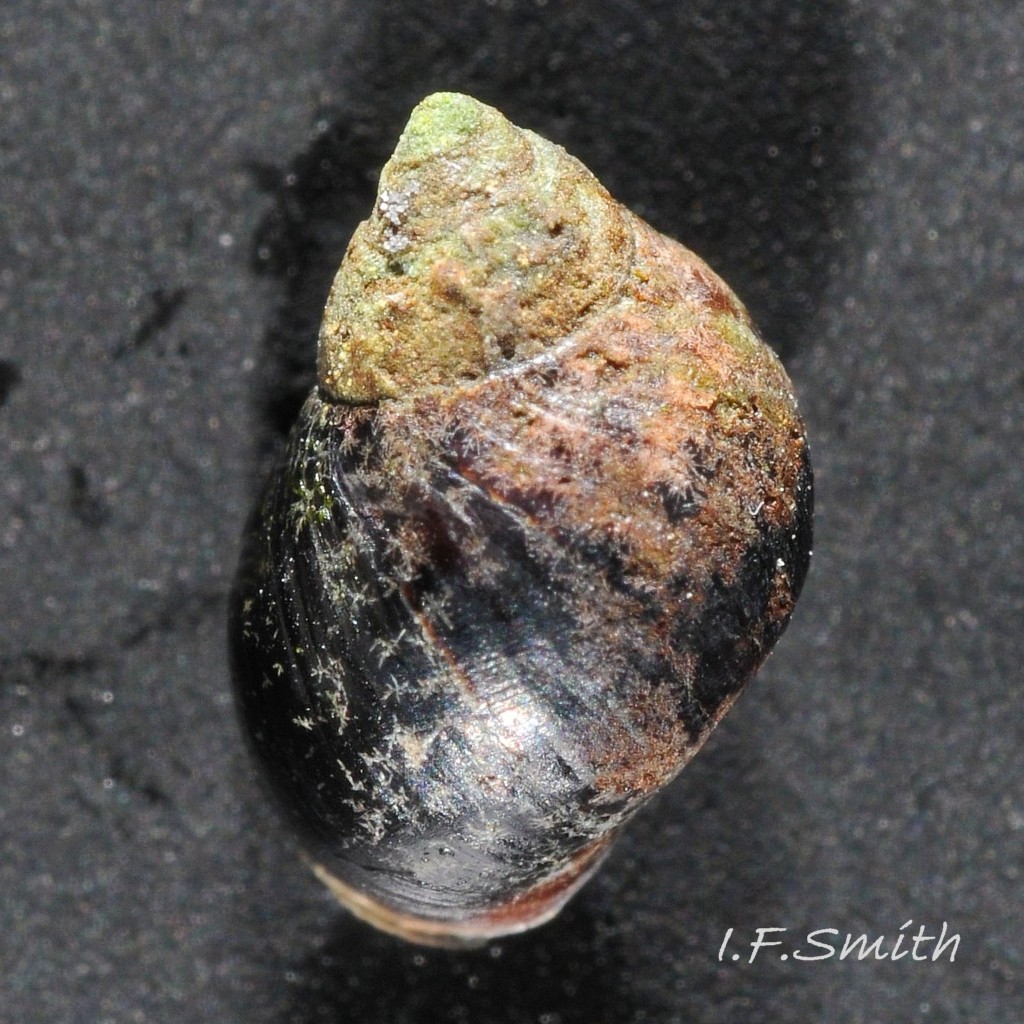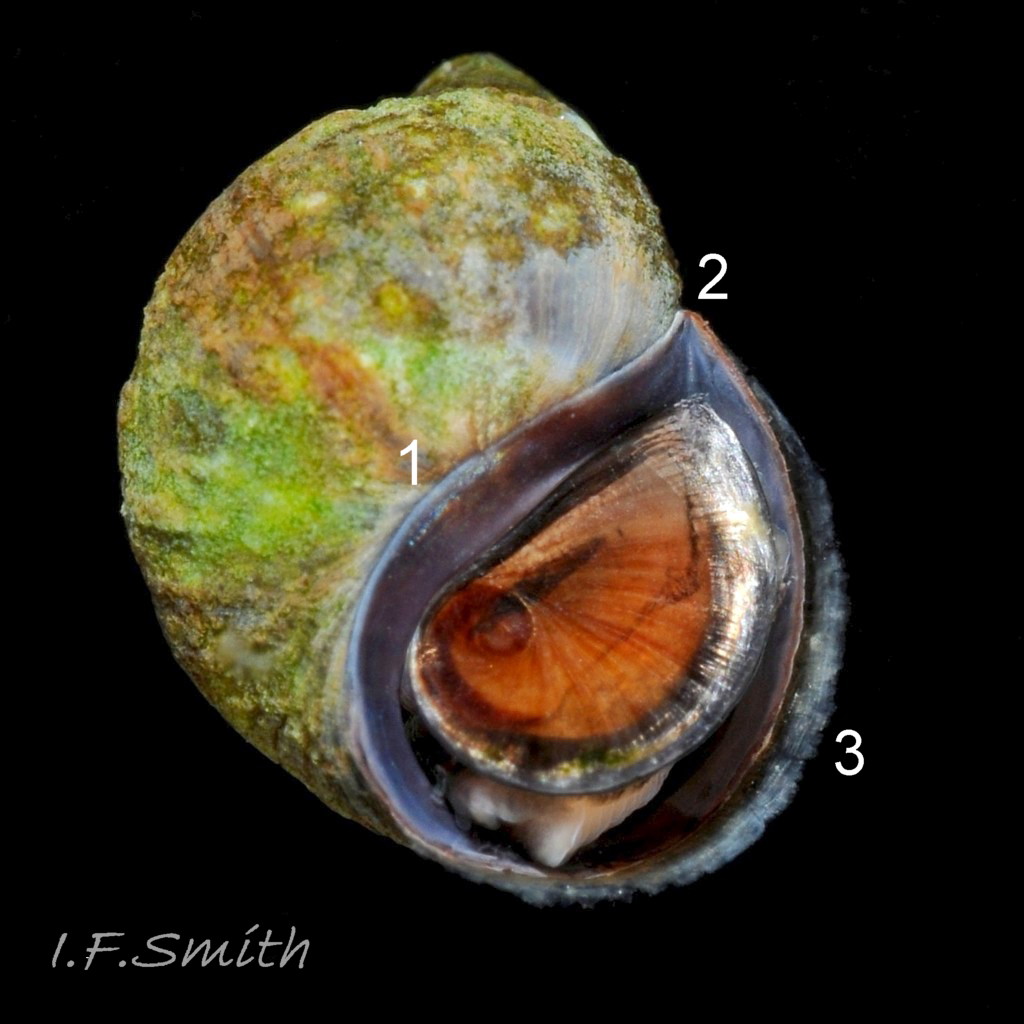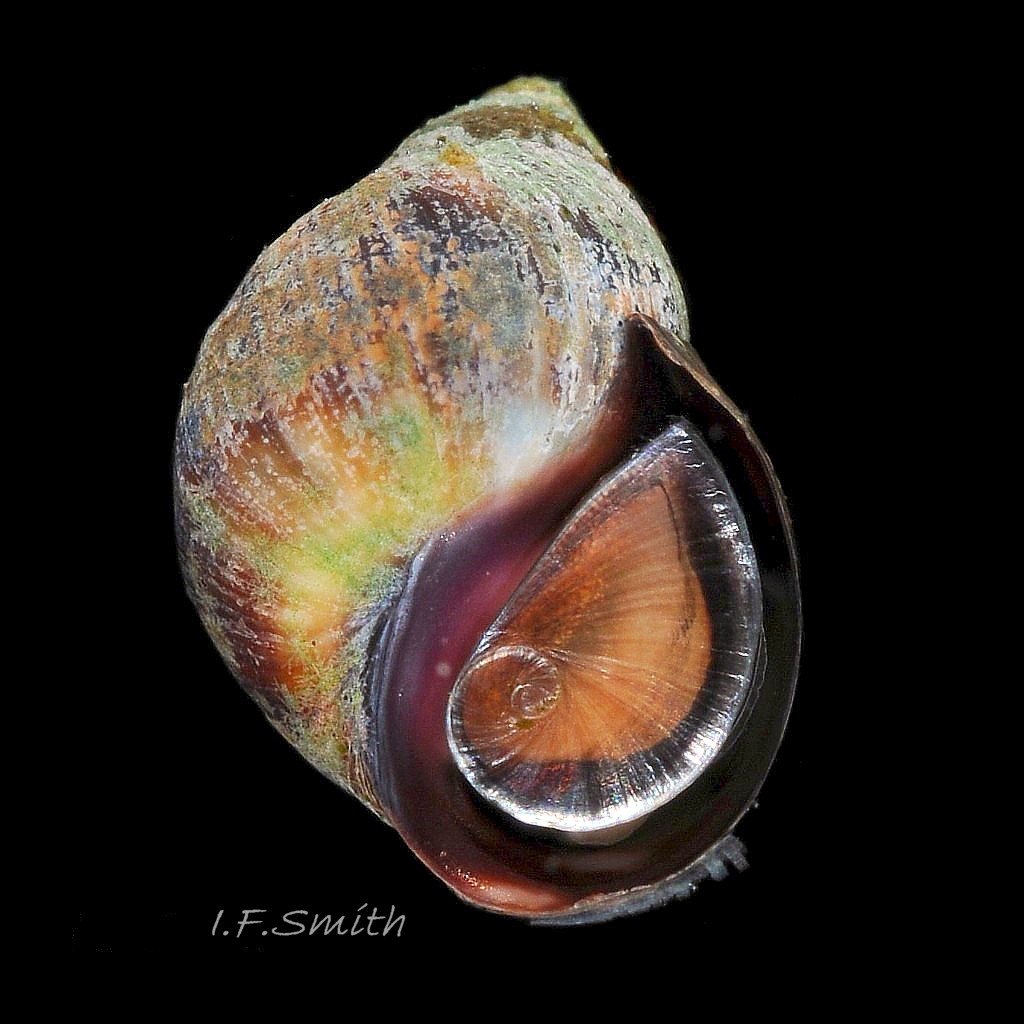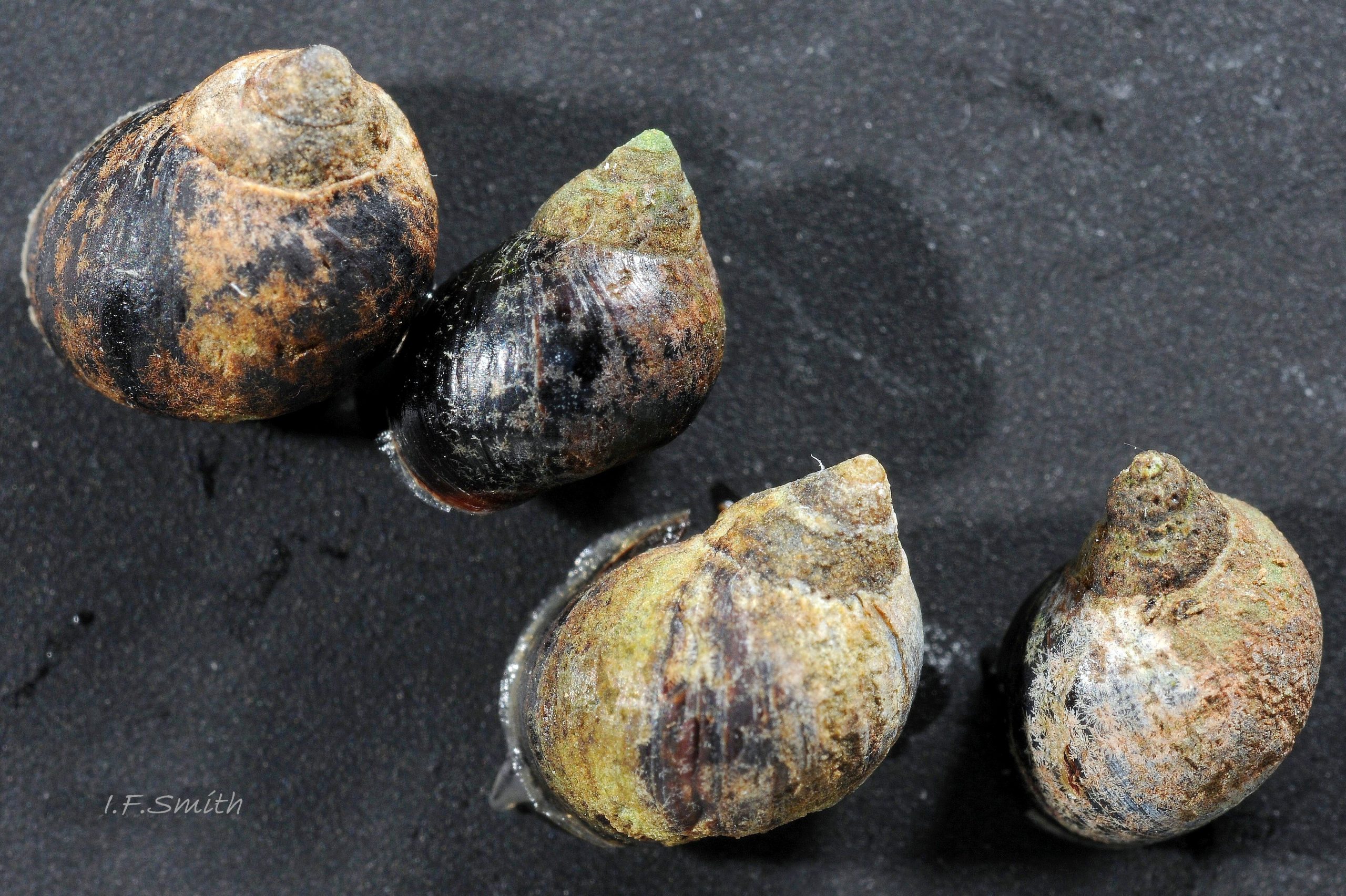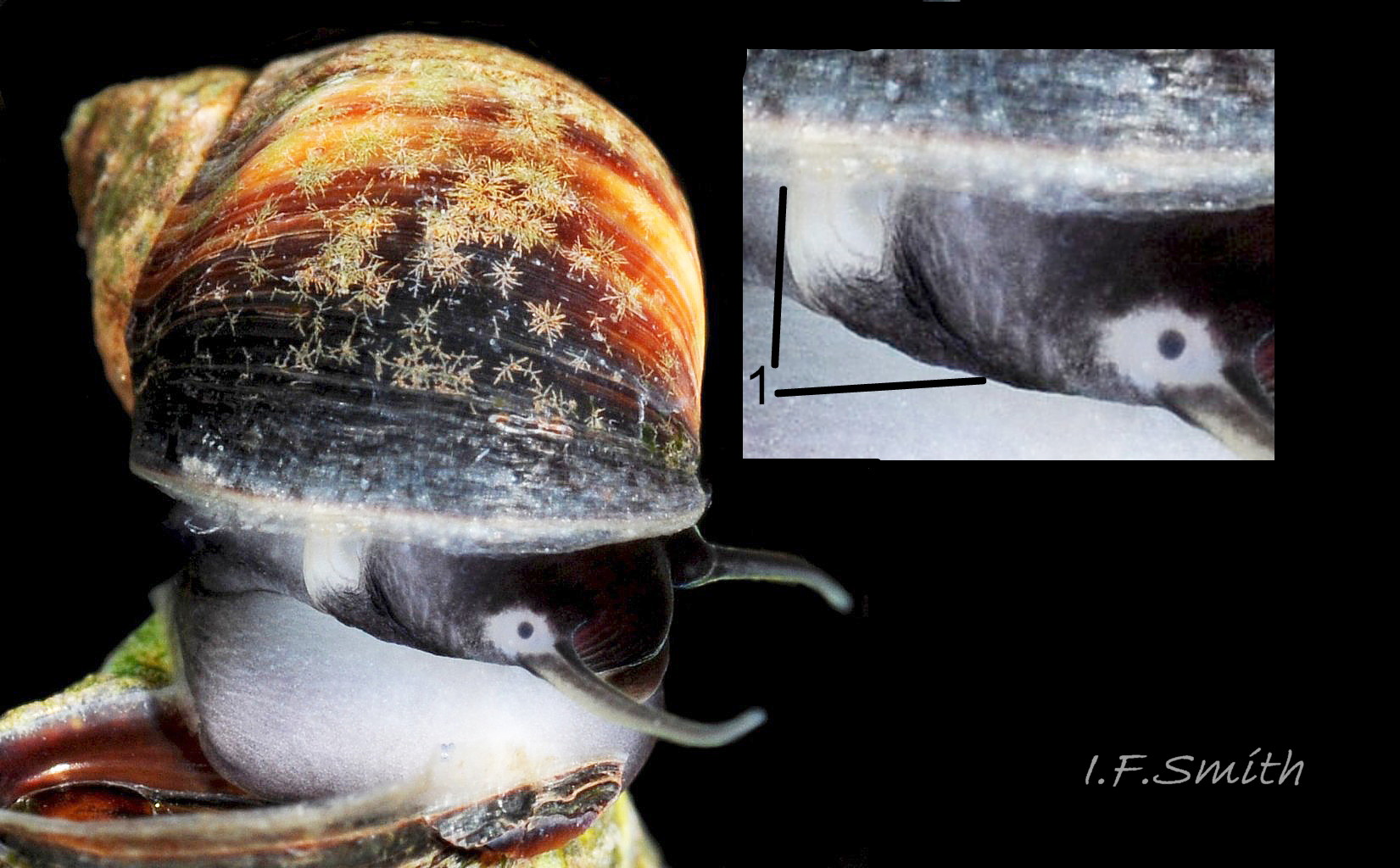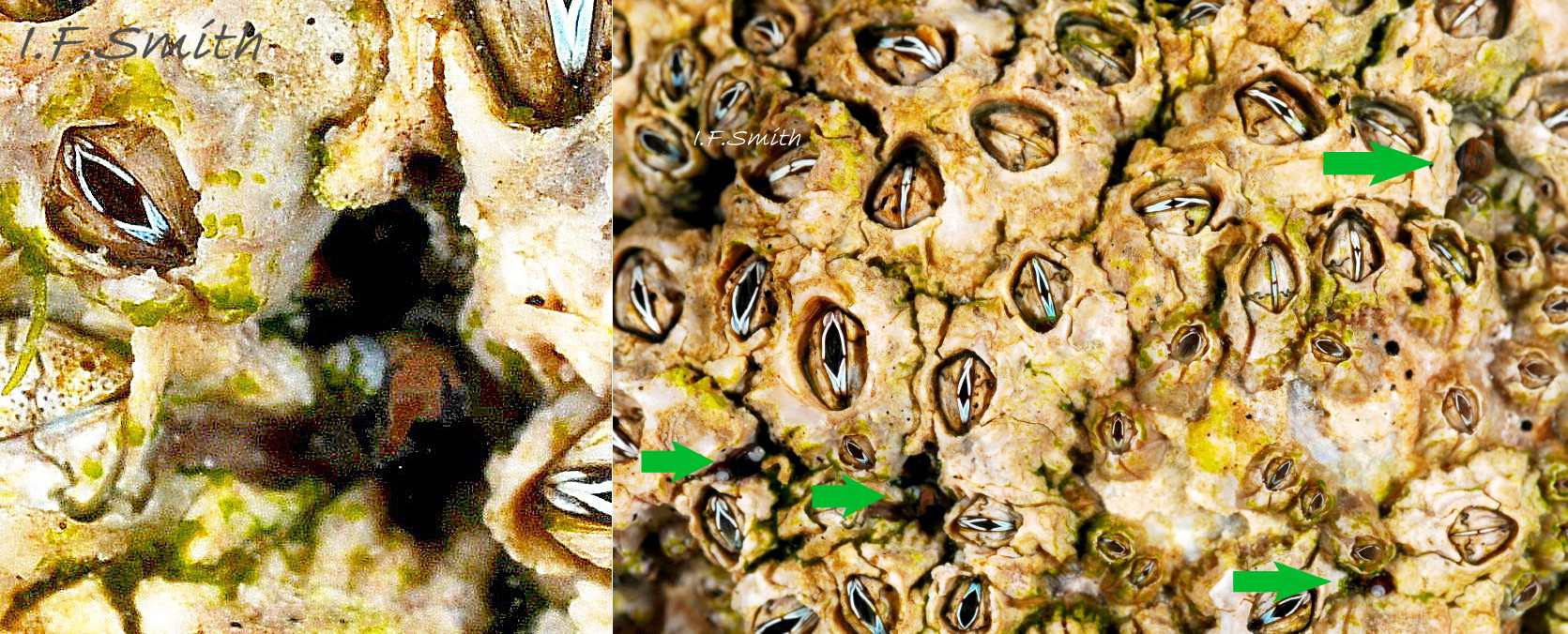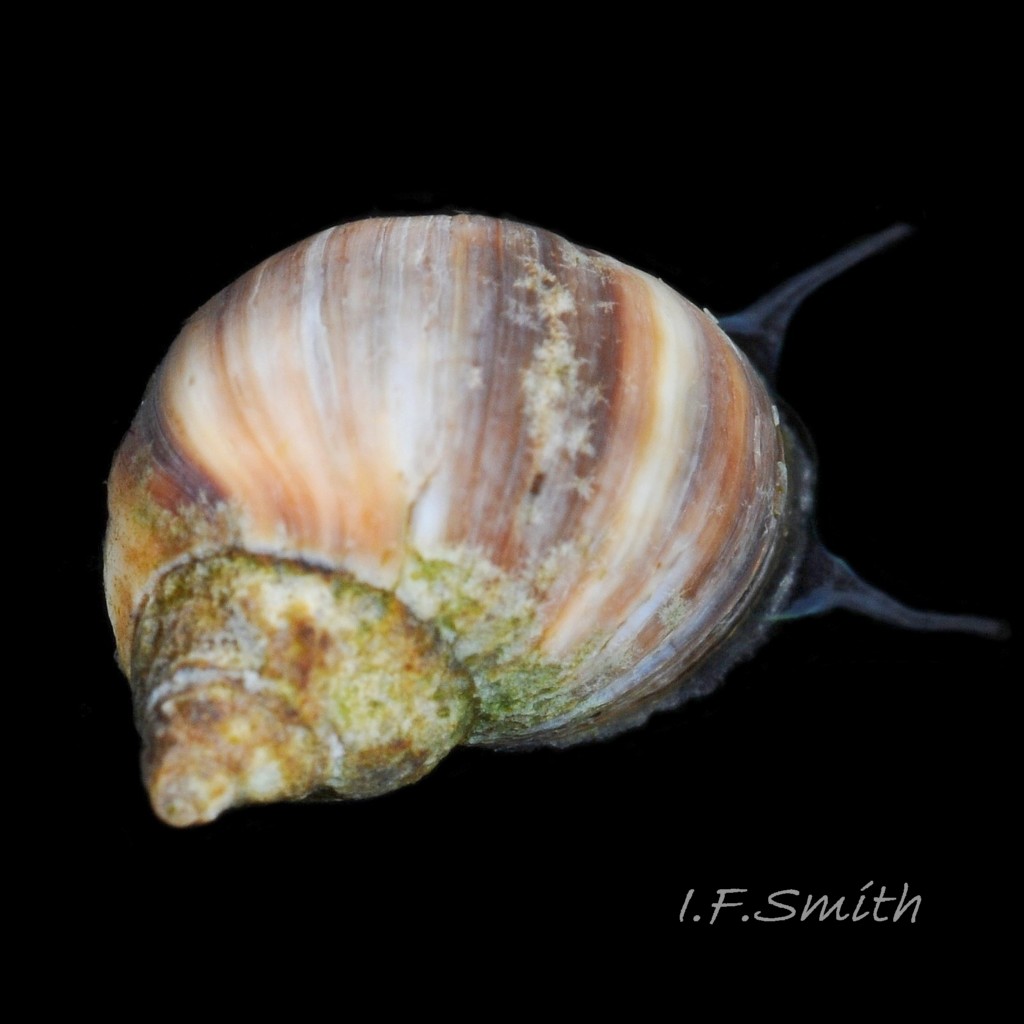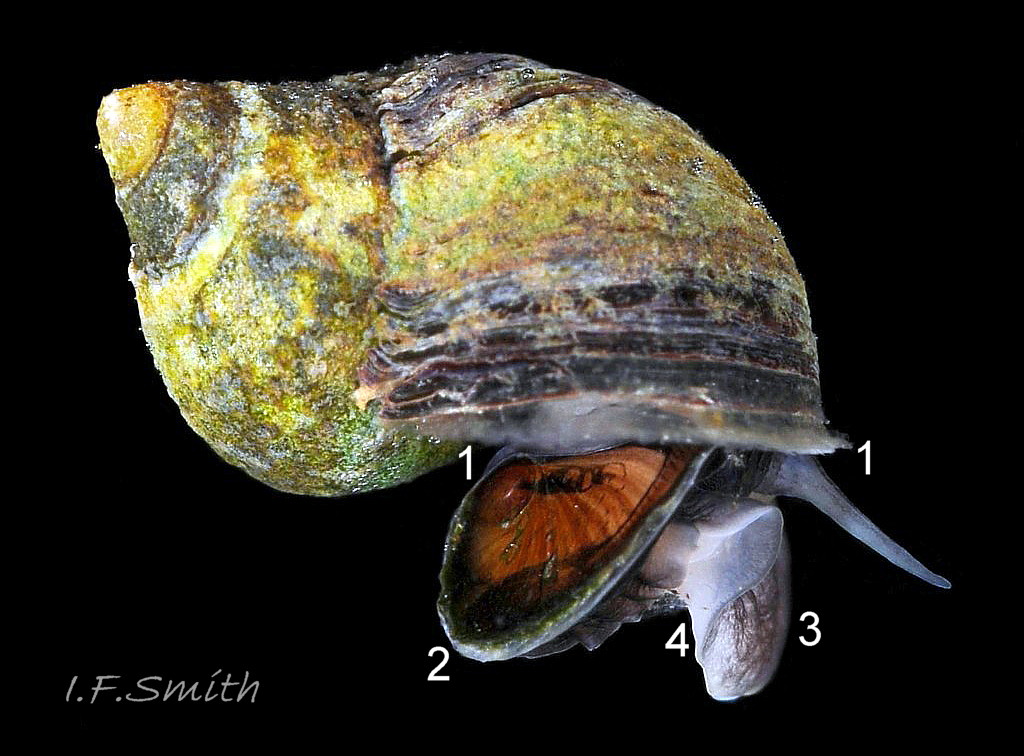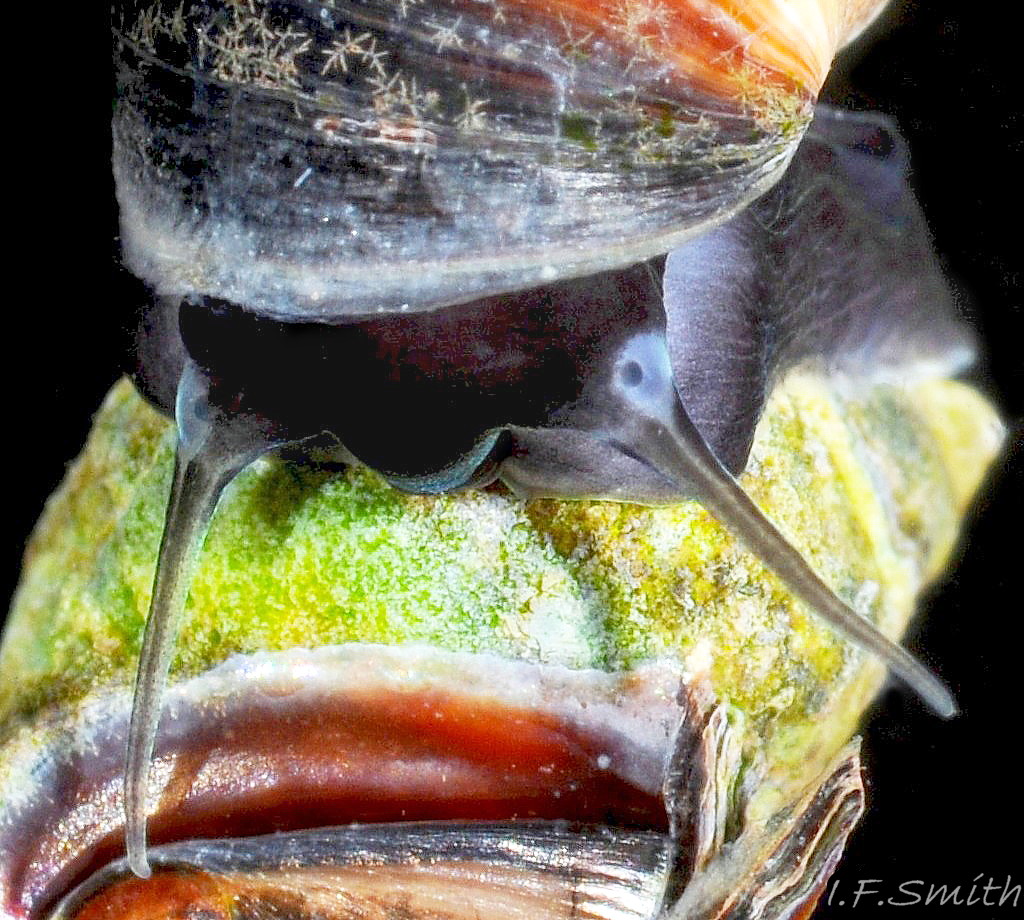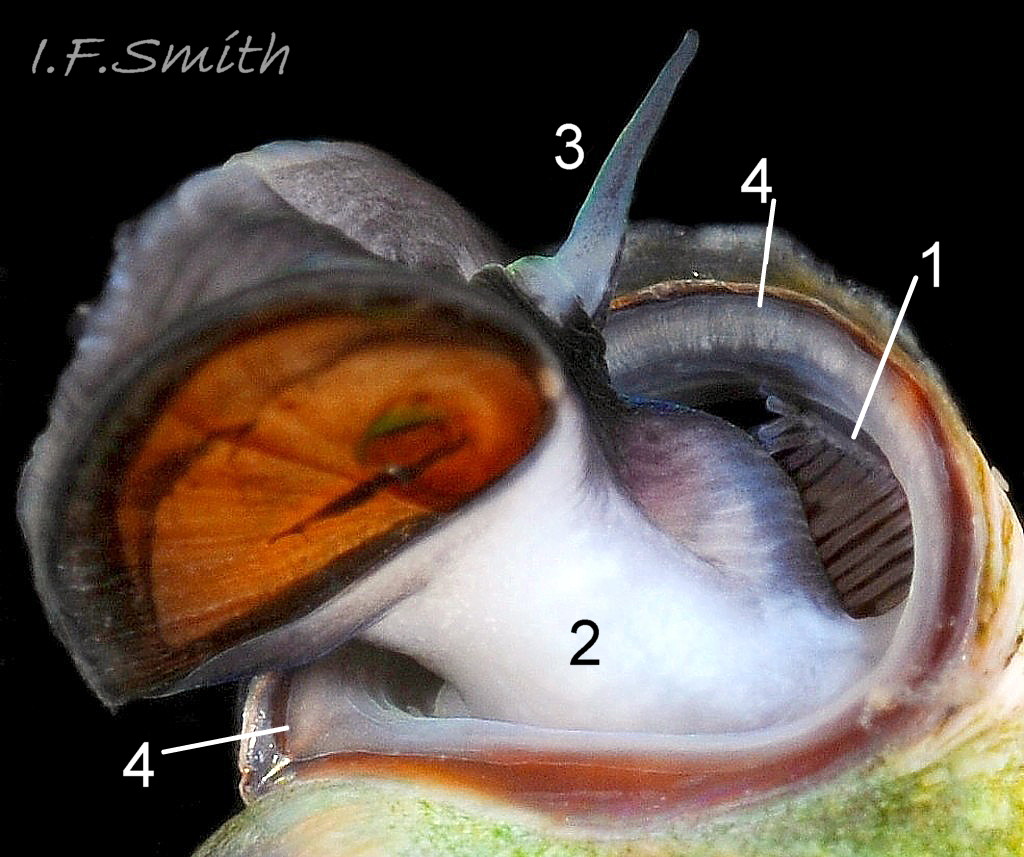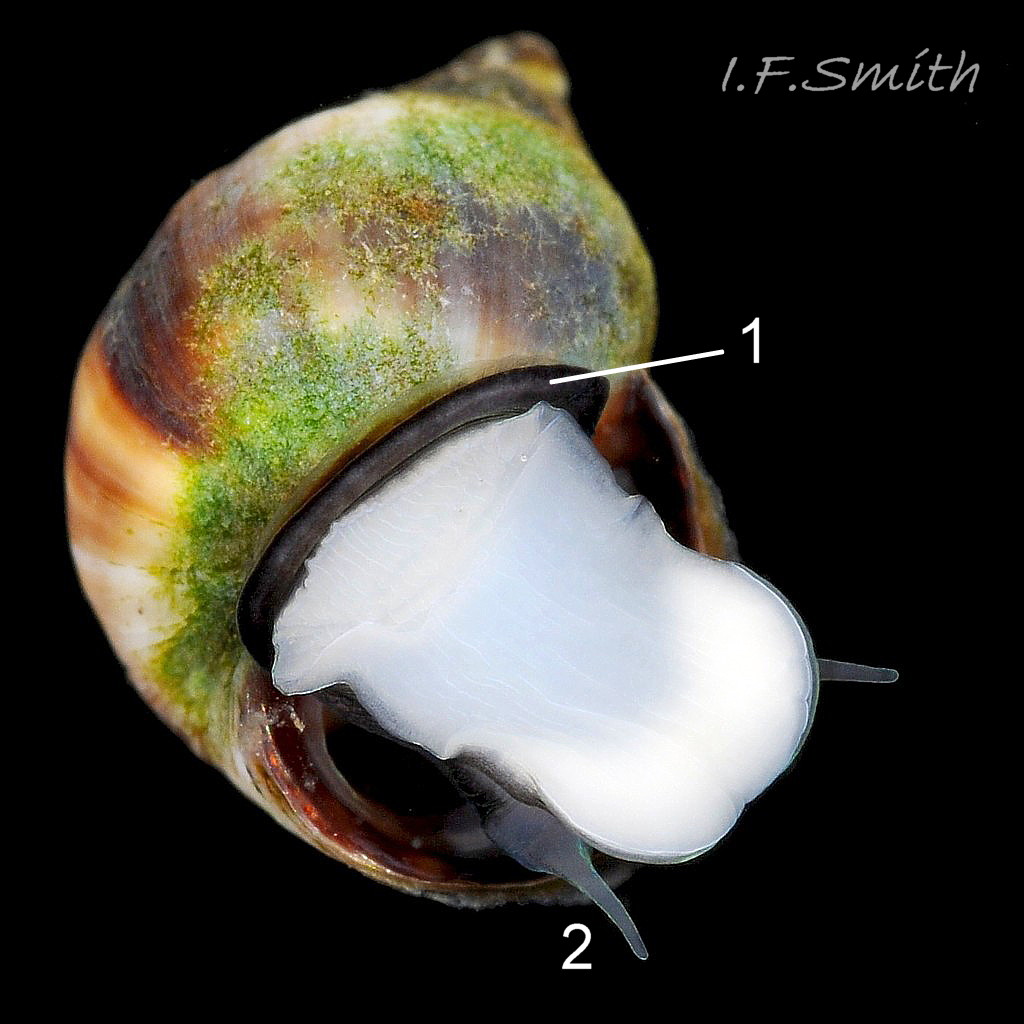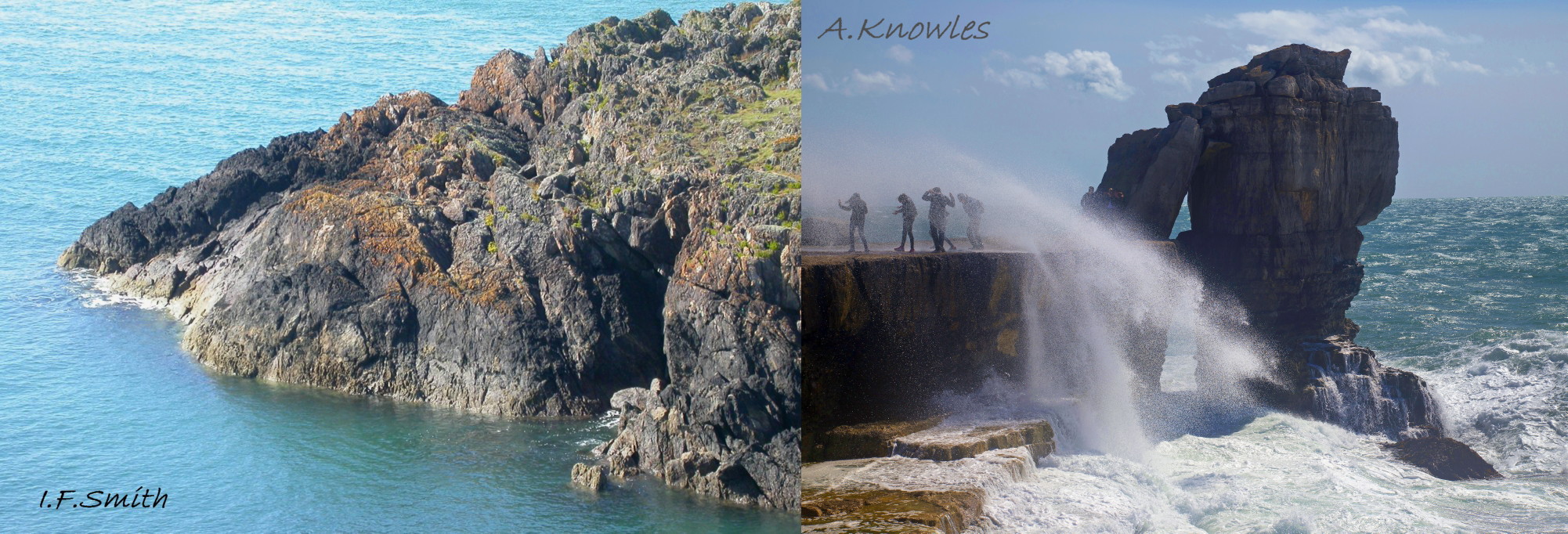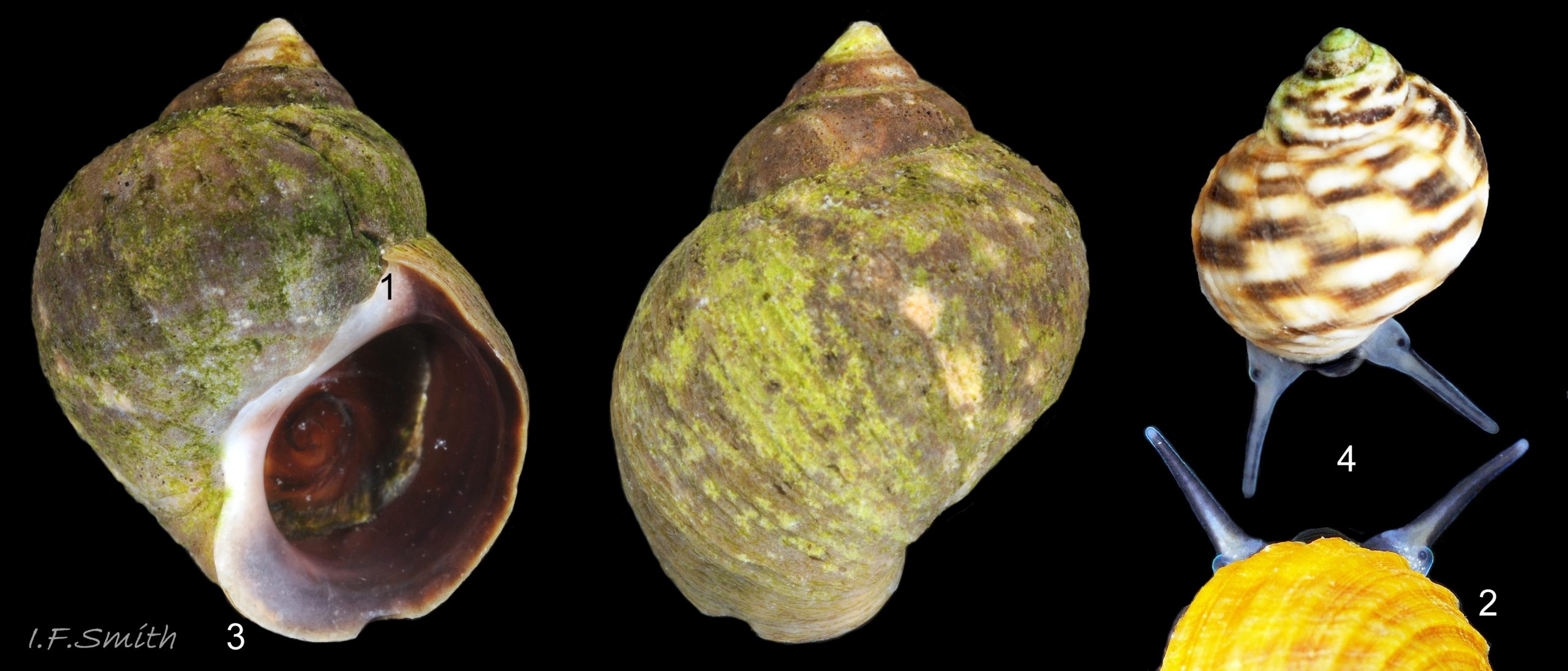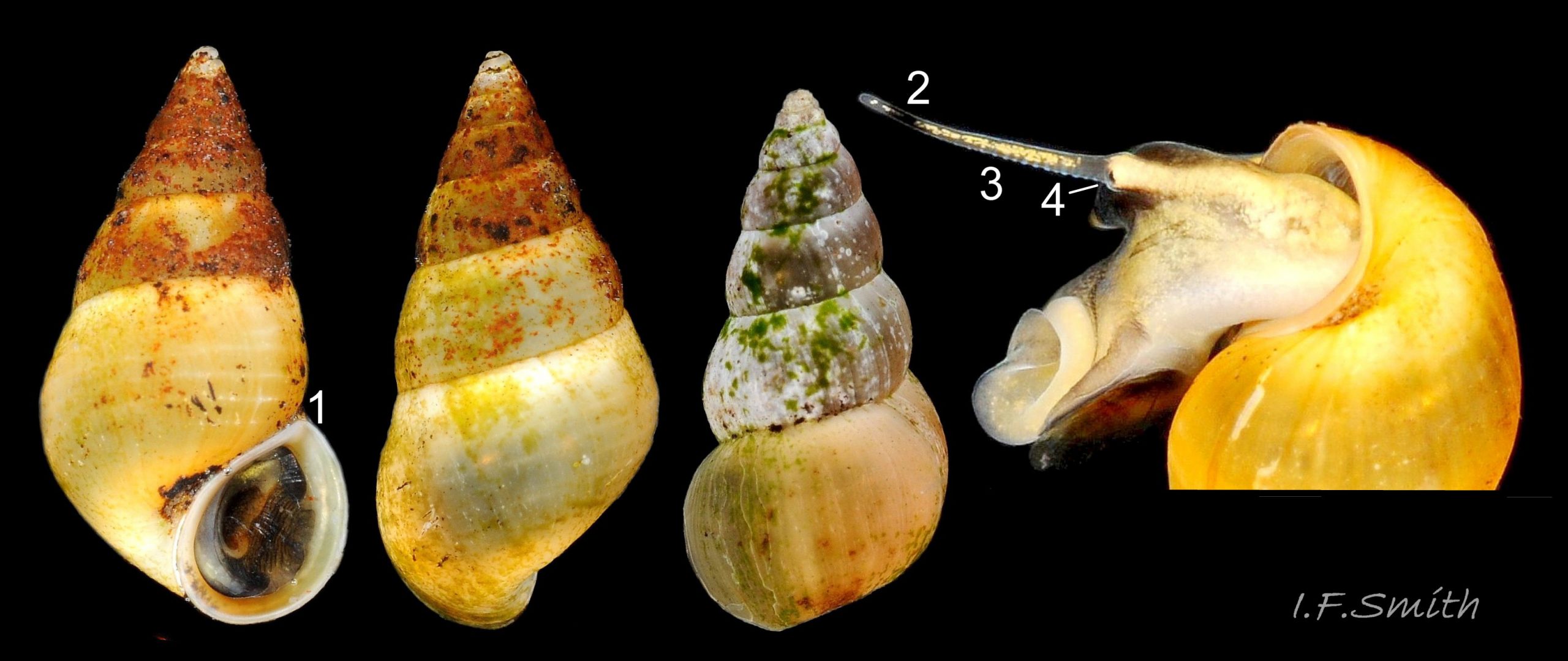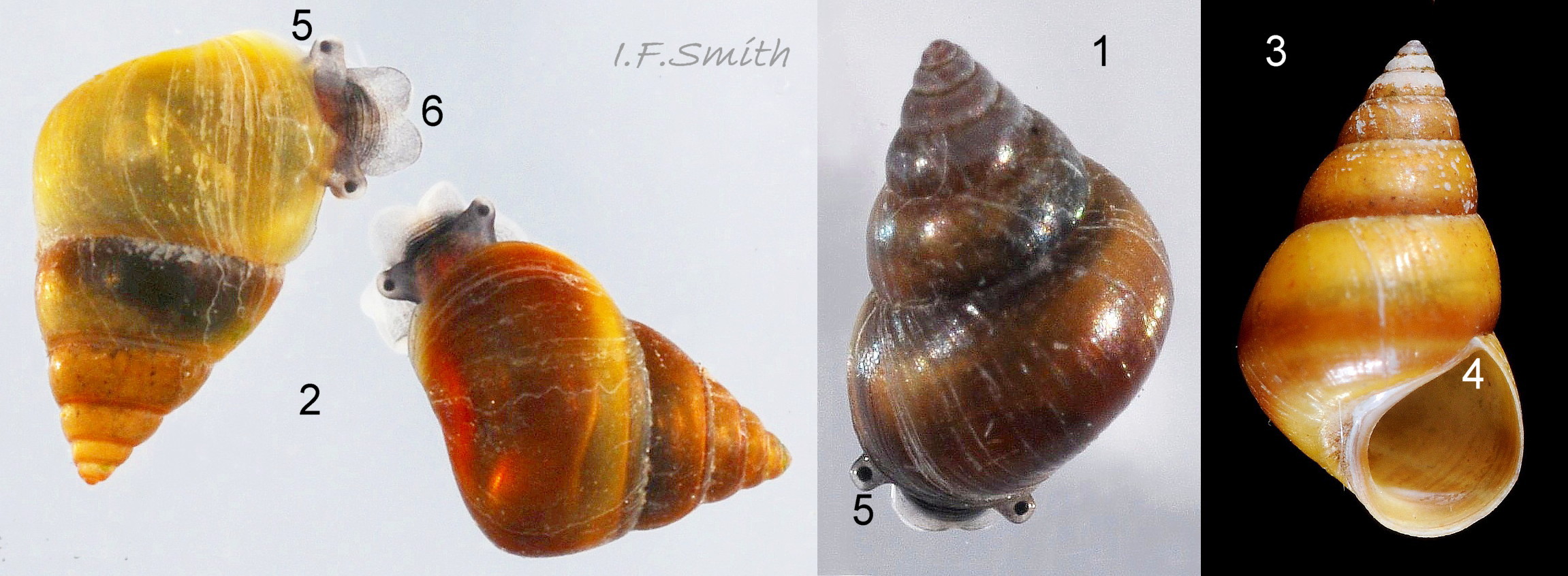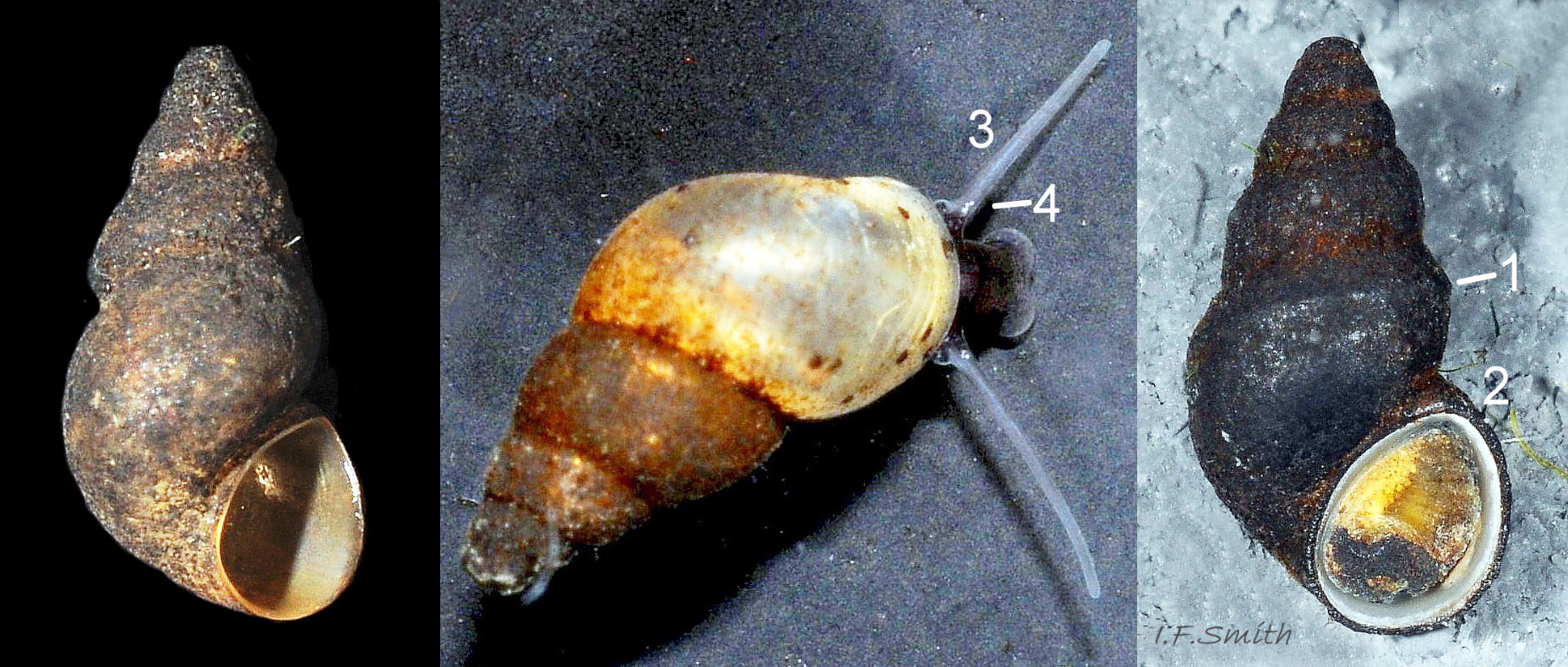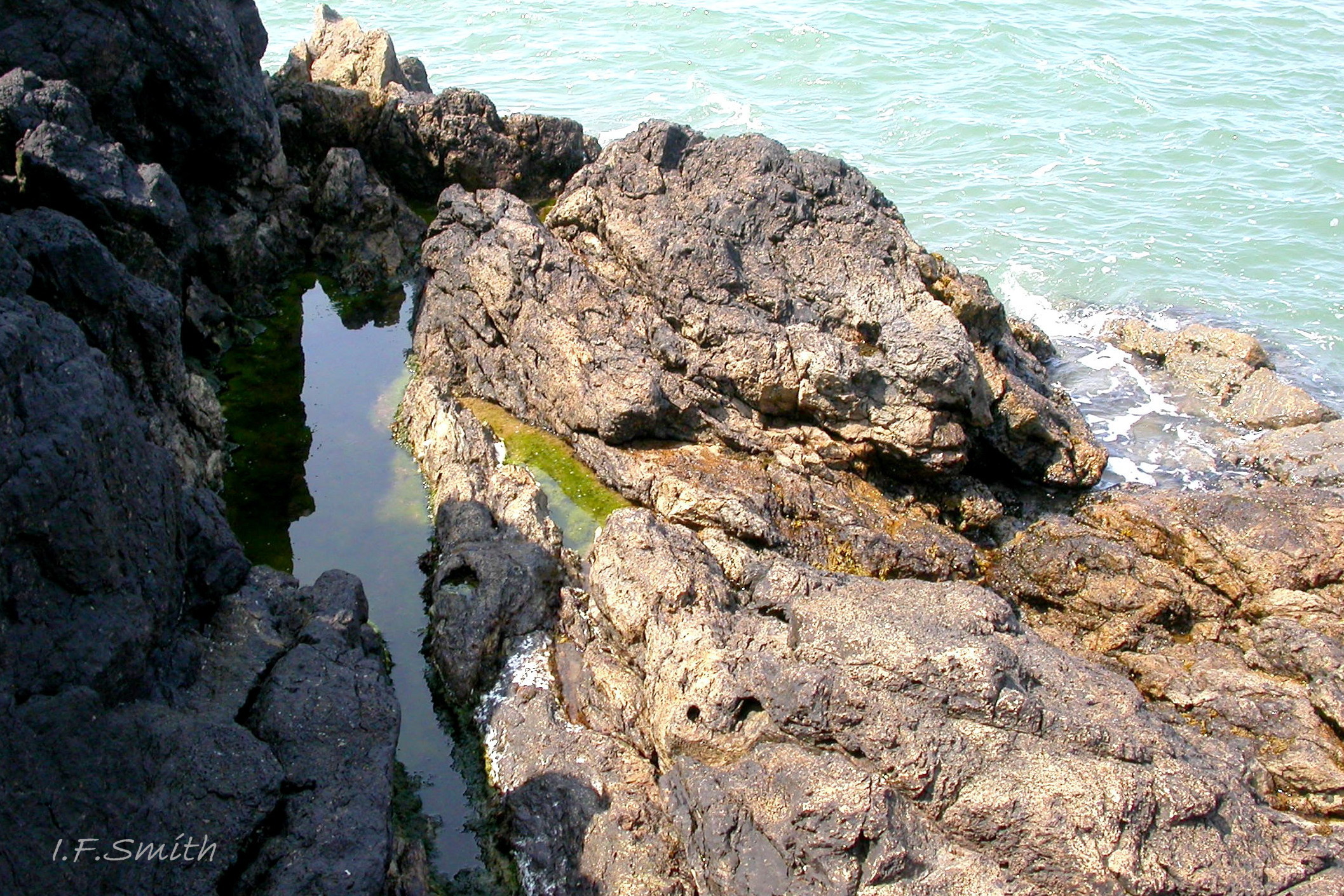Click image to enlarge with full caption. Main text below slider.
Melarhaphe neritoides (Linnaeus, 1758)
Synonyms:Littorina neritoides (Linnaeus, 1758); Littorina petraea Montagu, 1803;
Current taxonomy: World Register of Marine Species (WoRMS)
www.marinespecies.org/aphia.php?p=taxdetails&id=140266
Vernacular: Small periwinkle, Gwichiad bychan (Welsh)
GLOSSARY BELOW.
Shell Description
Up to 9 mm high, extreme maximum 10.5 mm. Spire about 36 % of height 03 Melarhaphe neritoides . Whorls almost flat so profile nearly straight. Surface smooth when uneroded, sometimes wrinkled by growth lines 01 Melarhaphe neritoides. . Sutures shallow. No umbilicus. Aperture over 50% of height, adapical angle acute 02 Melarhaphe neritoides . Translucent bright brown operculum a tear-shape spiral 03 Melarhaphe neritoides ; intense black rim of opercular lobe shows through. When uneroded with intact periostracum, shell is brown-black 01 Melarhaphe neritoides. often with a bluish bloom, but usually much of shell eroded to dirty fawn 04 Melarhaphe neritoides , sometimes stained green by algae 05 Melarhaphe neritoides . Erosion may commence as dendritic stars in periostracum 06 Melarhaphe neritoides . Juveniles below high water mark are less eroded, but pale spire lacks brown periostracum even when shell only 1 mm high 07 Melarhaphe neritoides . Occasional pale specimens with little obvious periostracum but minor shell erosion, show irregular transverse bands of white and browns 08 Melarhaphe neritoides on body whorl. Sometimes spiral whitish band on body whorl, but no spiral sculpture. Periostracum extends as flexible flap beyond outer lip on many 09 Melarhaphe neritoides .
Body description
Dorsal surfaces of body, foot and head grey-black 06 Melarhaphe neritoides . Long cephalic tentacles, grey-black dorsally with thin pale median line 10 Melarhaphe neritoides , whitish grey ventrally 11 Melarhaphe neritoides . Eye at base of tentacle in whitish disc 06 Melarhaphe neritoides . Snout projects forward of tentacles, often bent downwards 10 Melarhaphe neritoides . Sole white 12 Melarhaphe neritoides and ventral surfaces of body white 11 Melarhaphe neritoides . Opercular lobe has thick, intense black rim 12 Melarhaphe neritoides . Light grey mantle reaches rim of aperture when animal extended 11 Melarhaphe neritoides . Male has penis behind right tentacle, white basally, black distally 06 Melarhaphe neritoides . Behind right tentacle, female has ovipositor and cilia lined groove to bring ova to it from female aperture in mantle cavity. Light grey ctenidium (gill) within mantle cavity 1 11 Melarhaphe neritoides .
Key identification features
Melarhaphe neritoides
1) Adapical angle of shell aperture acute 02 Melarhaphe neritoides .
2) Shell smooth apart from growth lines; no spiral ridges or grooves 01 Melarhaphe neritoides. .
3) Usual maximum height 9 mm, rarely to 10.5 mm.
4) Periostracum brown / black-brown, sometimes with bluish bloom, usually eroded from spire 04 Melarhaphe neritoides .
5) Periostracum extends as flexible flap beyond outer lip on many 09 Melarhaphe neritoides .
6) Long cephalic tentacles, grey-black dorsally with thin pale median line 0 10 Melarhaphe neritoides .
7) Eye centrally in large whitish disc at base of long tentacles 06 Melarhaphe neritoides .
8) At and above EHWS on exposed rocky shores 13 Melarhaphe neritoides .
Similar species
Differentiation is simple if head and tentacles are examined and habitat is known. Misidentifications arise from relying on shell features alone. Of those listed, only L. saxatilis s.l. is found in the same habitat as M. neritoides; it is often mistaken for M. neritoides.
Littorina saxatilis/arcana 14 Melarhaphe neritoides
1) Adapical angle of shell aperture almost right angle.
2) Shell often has numerous spiral ridges when unworn.
3) Usual max. height 15 mm, juveniles and some varieties similar size to M. neritoides .
4) Periostracum unobtrusive; wide range of shell colours and patterns.
5) Pale columellar lip. No periostracal flap extending beyond outer lip.
6) Long cephalic tentacles, translucent whitish with pair of dorso-lateral blackish lines wide apart at base, converging adapically .
7) Eye at base of tentacle, in large whitish irregular area continuous with whitish tentacle, not a disc.
8) At and above EHWS on most rocky shores, also saltings. Found with M. neritoides, but not as high into splash zone, and also found below EWHS.
Peringia ulvae (Pennant, 1777) 15 Melarhaphe neritoides
1) Adapical angle of aperture acute.
2) Shell smooth.
3) Usually up to 6 mm high, exceptionally 10 mm.
4) Periostracum unobtrusive; shell whitish-brown, yellow-brown to dark brown.
5) No periostracal flap extending beyond outer lip.
6) Translucent tentacles with black subterminal band and, usually, many yellow/ white pigment flecks. Left tentacle thicker and less smooth than right tentacle.
7) Eye on anterior of yellowish or pinkish white patch at base of tentacle.
8) Salinity 5-40‰, usually estuarine mudflats or saltings with open tidal access.
Assiminea grayana Fleming, 1828 16 Melarhaphe neritoides
1) Adapical end of aperture pointed.
2) Shell smooth.
3) Usually up to 5 mm high, exceptionally 6.2 mm.
4) Substantial periostracum. Live shell looks blackish in air. Shades of brown when in water and well lit, sometimes banded.
5) Sometimes periostracum extends beyond outer lip.
6) Short blackish grey tentacles with eye visible dorsally near tip.
8) Near high water mark on saltings and tidal rivers to nearly 0‰ salinity, usually moist, but not submerged except just after high spring tide or flooding.
9) Snout terminates in two broad grey or whitish lobes, head darker 6Ag .
Potamopyrgus antipodarum (Gray, 1840) 17 Melarhaphe neritoides
1) Adapical angle of shell aperture rounded.
2) Shell smooth, occasionally keeled.
3) Usually up to 5 mm high, exceptionally 5.5 mm.
4) Periostracum gives shell a translucent yellowish horn-colour, but often only visible on most recent whorl as black or brown mineral deposit very often obscures the spire.
5) Periostracum does not extend beyond outer lip.
6) Translucent grey tentacles often with fine white medial line, no subterminal black mark.
7) White flecks often on tentacle in front of eye.
8) Primarily in flowing fresh water, but also in brackish ditches and lagoons to 17 ‰ salinity.
Habits and ecology
Exposed rocky shores, especially steep rough rocks with many crevices for shelter from storm wave impact 13 Melarhaphe neritoides . Adults almost terrestrial, living in supralittoral splash and spray zone from Pelvetia level at EHWS, often to 4 m above EHWS in black lichen zone, and to about 20 m above in extreme exposure. Overlaps with Littorina saxatilis, but M. neritoides extends further up. On shores with minimal splash may live below EHWS. Usually scarce or absent on sheltered coast in Britain, but apparently not so in southern Europe. Juveniles settle from plankton at lower levels, sheltering in cavities among barnacles from wave impact 07 Melarhaphe neritoides . They migrate up shore as they grow and become able to withstand long exposure to air.
Respiration by ctenidium with few small leaflets 11 Melarhaphe neritoides , but efficient; can survive in water with very little oxygen. Out of water, the mantle acts as lung for atmospheric air. It moves, feeds and mates when immersed and when un-submerged if much sea spray or calm with light rain or heavy mist. Can live up to five months without immersion, survive temperatures up to 46º C and live in freshwater or water of treble normal salinity of seawater for a week. In hot arid conditions, the flexible periostracal flap 09 Melarhaphe neritoides on the aperture lip is glued to rock with dried mucus, and the foot withdrawn from the substrate. Feeds on algal detritus, diatoms and, possibly, black lichen. Breeds autumn – spring. Capsules, 0.18mm diameter, containing one egg each, released into plankton; capsule a thick rimmed disc with convex faces. The only other British caenogastropod to release planktonic capsules is Littorina littorea, but it has several eggs per capsule. Capsules released when female immersed by storm waves or by high spring tide if she migrates below EHWS to spawn. Veligers hatch and live in plankton before settling and metamorphosing on rock bare of algae below EHWS. Juveniles shelter in crevices among barnacles; at 1 mm height the spire lacks periostracum 07 Melarhaphe neritoides . They migrate above EHWS when they grow and can withstand desiccation. Growth slows when 6 mm high; 7 mm specimens probably 5 years old 05 Melarhaphe neritoides .
Distribution and status
Southern Norway and Shetland to Morocco and Canary Islands, Mediterranean and Black Sea. GBIF map www.gbif.org/species/4361922 . Until recently scarce or absent from southern North Sea, but recently spreading in the Netherlands. Widespread and common around most of Britain and Ireland on exposed rocky shores. Until recently, absent from the two areas of Britain with coldest winter sea temperature; Kent to near Flamborough Head, and north-east Irish Sea, including areas with suitable rock and exposure 18 Melarhaphe neritoides, Recent scattered reports suggest it may be moving into these areas with climate warming. U.K. map NBN species.nbnatlas.org/species/NBNSYS0000176399 The south coast of Scotland records by Scottish Natural Heritage on NBN (accessed January 2022) further east than Wigtownshire are obviously misidentifications, probably of Littorina saxatalis, as they are from very sheltered, soft substrate/salting habitats, radically different from its favoured rocks exposed to waves and spray.
Acknowledgements
I thank Andy Knowles for use of his image of spray at Portland Bill.
References
Fretter, V. and Graham, A. 1962. British prosobranch molluscs: their functional anatomy and ecology. London, Ray Society.
Graham, A. 1988. Molluscs: prosobranch and pyramidellid gastropods. Synopses of the British Fauna (New Series) no.2 (Second edition). Leiden, E.J. Brill/Dr. W. Backhuys. pp.662.
Lewis, J.R. 1964. The ecology of rocky shores. London, Hodder and Stoughton.
Yonge, C. M. and Thompson, T. E. 1976. Living marine molluscs. London, Collins.
GLOSSARY
‰ = (salinity) parts salt per thousand parts water (brackish <30‰).
abapical = away from the apex of the shell.
adapical = towards the apex of the shell.
aperture = mouth of gastropod shell; outlet for head and foot.
apical = at the apex.
cephalic = (adj.) of the head.
chitin = semitransparent flexible horny material.
chitinous = (adj.) made of chitin.
ctenidium = comb-like molluscan gill; usually an axis with a row of leaflets either side.
dendritic = branching like a tree’s boughs, branches and twigs.
dorso-lateral = at or near junction/merging of dorsal and lateral surfaces.
EHWS = (level of) extreme high water spring tide (usually near March and September equinoxes).
operculum = horny, chitinous plate used to close shell aperture.
ovipositor = structure used in depositing spawn.
periostracum = thin horny layer of chitinous material often coating shells.
periostracal flap = extension of periostracum as flexible flap beyond outer lip of gastropod aperture.
plankton = animals and plants that drift in pelagic zone (main body of water).
salting = area of salt tolerant vascular plants rooted in sediment between mean high water mark (MHW) and extreme high water of spring tides (EHWS). [Preferred synonym for “saltmarsh” as much of salting not marshy.]
supralittoral = above level of extreme high water of spring tide.
subterminal = a short distance from the end.
suture = groove or line where whorls adjoin.
umbilicus = cavity up axis of some gastropods, open as a hole or chink on base of shell, often sealed over.
veliger = shelled larva of marine gastropod or bivalve mollusc which swims by beating cilia of a velum (bilobed flap).
velum = bilobed flap on veliger larva, with beating cilia for swimming.
